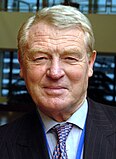General election held in the United Kingdom
1997 United Kingdom general election in England † Notional 1992 results if held on the 1997 boundaries
The 1997 United Kingdom general election in England was held on 1 May 1997 for 529 English seats to the House of Commons. Under Tony Blair , the Labour Party won a landslide majority of English seats, the first time since 1966 that Labour had won an overall majority of English seats.[ 2] Scotland and Wales, gave Labour the biggest majority for any single party since 1931 . Blair subsequently formed the first Labour government since 1979, beginning 13 years of Labour government.
Party[ 2] Seats Votes Total Gains Losses Net +/- % seats Total votes % votes Change Labour 328 133 1 62.0 11,347,882 43.5 Conservative 165 0 159 31.2 8,780,881 33.7 Liberal Democrats 34 26 1 6.4 4,677,565 18.0 Referendum 0 0 0 — 746,624 2.9 N/A UKIP 0 0 0 — 103,521 0.4 N/A Independent 1 1 0 0.2 69,464 0.3 Green 0 0 0 — 60,013 0.2 Liberal 0 0 0 — 44,516 0.2 Socialist Labour 0 0 0 — 44,114 0.2 N/A BNP 0 0 0 — 35,181 0.1 Natural Law 0 0 0 — 25,958 0.1 Independent Labour 0 0 0 — 24,447 0.1 Speaker 1 1 0 0.2 24,447 0.1 N/A Ind. Conservative 0 0 0 — 18,667 0.1 Prolife Alliance 0 0 0 — 13,890 0.1 N/A Other parties 0 0 0 — 42,020 0.2 N/A 26,058,712 71.5
Popular vote Labour
43.5% Conservative
33.7% Liberal Democrats
18.0% Referendum
2.9% Other
2.1%
Parliament seats Labour
62.0% Conservative
31.2% Liberal Democrats
6.4% Other
0.4%
Regional vote shares and changes are sourced from the House of Commons Library.[ 3]
Party Seats Votes Total Gained Lost Net Total % Change (%) Labour 28 +3 862,262 64.0 +10.7 Conservative 1 -3 266,294 19.8 -11.0 Liberal Democrats 1 169,270 12.6 -2.9 Others 0 48,764 3.6 — Total 30 Turnout 1,346,590
Party Seats Votes Total Gained Lost Net Total % Change (%) Labour 49 +13 1,499,518 51.5 +9.0 Conservative 9 -14 859,436 29.5 -11.3 Liberal Democrats 1 421,025 14.5 -1.0 Others 1 +1 130,730 4.5 — Total 60 Turnout 2,910,709
Party Seats Votes Total Gained Lost Net Total % Change (%) Labour 15 +3 442,366 64.0 +10.4 Conservative 0 -4 141,120 19.8 -9.3 Liberal Democrats 1 +1 103,152 12.6 -2.4 Others 0 28,158 3.6 — Total 16 Turnout 714,796
Yorkshire and the Humber [ edit ] Party Seats Votes Total Gained Lost Net Total % Change (%) Labour 47 +13 1,339,170 51.9 +7.6 Conservative 7 -15 720,771 28.0 -10.0 Liberal Democrats 2 +2 412,216 16.0 -0.8 Others 0 106,016 4.1 — Total 56 Turnout 2,578,173
Party Seats Votes Total Gained Lost Net Total % Change (%) Labour 30 +15 1,097,639 47.8 +10.4 Conservative 14 -15 800,958 34.9 -11.7 Liberal Democrats 0 311,264 13.6 -1.7 Others 0 84,889 3.7 — Total 44 Turnout 2,294,750
Party Seats Votes Total Gained Lost Net Total % Change (%) Labour 43 +15 1,326,822 47.0 +8.2 Conservative 14 -17 953,465 33.7 -11.0 Liberal Democrats 1 +1 388,807 13.8 -1.3 Others 1 +1 156,731 5.5 — Total 59 Turnout 2,825,825
Party Seats Votes Total Gained Lost Net Total % Change (%) Conservative 33 -19 1,164,777 39.5 -13.0 Labour 22 +18 1,137,637 38.6 +12.2 Liberal Democrats 1 +1 504,416 17.1 -2.7 Others 0 140,337 4.8 — Total 56 Turnout 2,947,167
Party Seats Votes Total Gained Lost Net Total % Change (%) Labour 57 +25 1,643,329 49.5 +12.4 Conservative 11 -30 1,036,082 31.2 -14.1 Liberal Democrats 6 +5 485,511 14.6 -1.3 Others 0 156,126 4.7 — Total 74 Turnout 3,321,048
Party Seats Votes Total Gained Lost Net Total % Change (%) Conservative 54 -25 1,817,343 41.9 -13.1 Labour 22 +18 1,264,778 29.1 +10.2 Liberal Democrats 7 +7 1,012,418 23.3 -1.4 Others 0 247,069 5.7 — Total 83 Turnout 4,341,608
Party Seats Votes Total Gained Lost Net Total % Change (%) Conservative 22 -17 1,020,635 36.7 -10.8 Liberal Democrats 14 +8 869,486 31.3 -0.1 Labour 15 +9 734,361 26.4 +7.2 Others 0 153,564 5.5 — Total 51 Turnout 2,778,046


 French
French Deutsch
Deutsch

